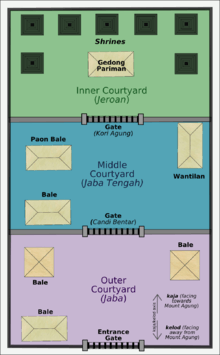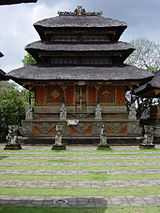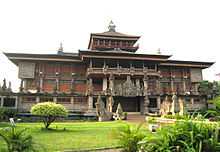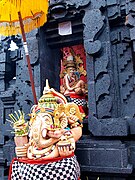Balinese architecture
.jpg)
Balinese architecture is a vernacular architecture tradition of Balinese people that inhabits volcanic island of Bali, Indonesia. The Balinese architecture is a centuries-old architectural tradition influenced by Balinese culture developed from Hindu influences through ancient Javanese intermediary, as well as pre-Hindu elements of native Balinese architecture.[1]
Today, contemporary Balinese style is known as one of the most popular Asian tropical architecture, due largely to the growth of the tourism industry in Bali that has created demand for Balinese-style houses, cottages, villas and hotels. Contemporary Balinese architecture combines traditional aesthetic principles, island's abundance of natural materials, famous artistry and craftmanship of its people, as well as international architecture influences, new techniques and trends.
Materials
Balinese buildings are in complete harmony with the environment. They uses natural materials such as thatch roofing, bamboo poles, woven bamboo, coconut wood, teak wood, brick and stone. The thatched roof usually uses ijuk (black aren fibers), dried coconut or rumbia leaves, or sirap (hard wood shingles arranged like tiles) roof. Stones and red bricks are usually used as foundation and walls, while sandstone and andesite stone are usually carved as ornamentation.
Balinese people are known for their artistry, they has developed a sophisticated sculpting tradition that manifest in architecture rich ornamentation and interior decoration. Balinese temples and palaces are exquisitely decorated with rich ornamentations — both wooden and stone sculpting — usually depicts floral patterns. Balinese sculpture often served as gate guardians as twin dvarapalas flanking entrances. The gates itself are richly decorated with kala's head, floral ornaments, and vajra or ratna pinnacles. Other types of sculpture are often served as ornamentation, such as goddess or dragon waterspouts in bathing places.
Philosophy


Balinese architecture is developed from Balinese ways of life, their spatial organization, their communal-based social relationships, as well as philosophy and spirituality influenced its design; much owed to Balinese Hinduism. The philosophical and conceptual basis underlining development of Balinese traditional architecture includes several concepts such as:[2]
- Tri Hita Karana: the concept of harmony and balance consists of three elements; atma (human), angga (nature), and khaya (gods). Tri Hita Karana prescribe three ways that a human beings must strive to nurture harmonious relationship with; fellow human beings, nature, and God.
- Tri Mandala: the rules of space division and zoning. Tri Mandala is spatial concept describing three parts of realms, from Nista Mandala — the outer and lower mundane less-sacred realm, Madya Mandala — the intermediate middle realm, to Utama Mandala — the inner and higher most important sacred realm.
- Sanga Mandala: also the rules of space division and zoning. The Sanga Mandala is the spatial concept concerning with directions that divide an area into nine parts according to eight main cardinal directions and central (zenith). These nine cardinal directions is connected to Hindu concept of Guardians of the directions, Dewata Nawa Sanga or nine guardian gods of directions that appear in Majapahit emblem Surya Majapahit. They are; Center: Shiva, East: Isvara, West: Mahadeva, North: Vishnu, South: Brahma, Northeast: Sambhu, Northwest: Sangkara, Southeast: Mahesora, and Southwest: Rudra.
- Tri Angga: the conception of hierarchy from microcosm, middle realm, and macrocosm. It is also connected to the next concept tri loka.
- Tri Loka: also the conception of hierarchy between three realms bhur (Sanskrit:bhurloka) lower realm of animals and demons, bhuwah (Sanskrit:bhuvarloka) middle realm of human, and swah (Sanskrit:svarloka) upper realms of gods and deities.
- Asta Kosala Kosali: the eight guidelines for architectural designs, which includes the shapes of niyasa (symbols) in pelinggih (shrine), pepalih (stages), its measurement units, shapes and size, also dictate appropriate decorations.
- Arga Segara or Kaja Kelod: the sacred axis between. arga or kaja (mountain) and segara or kelod (sea). Mountain region are considered as parahyangan, the abode of hyang or gods, middle plain in between are the realm of human, and the sea as the realm of sea monster and demons.
Other than artistic and technical mastery, all Balinese architect (Balinese:Undagi) are required to master these Balinese philosophical concepts concerning form, architecture, and spatial organization.
Religious architecture
Balinese temple or pura (Sanskrit for:"walled city") are designed as an open air place of worship within enclosed walls, connected with a series of intricately decorated gates between its compounds. This walled compounds contains several shrines, meru (towers), and bale (pavilions). The design, plan and layout of the pura follows the Tri Mandala concept of Balinese space allocation.[3] The three mandala zones are Nista Mandala (jaba pisan): the outer zone, Madya Mandala (jaba tengah): the middle zone, and Utama Mandala (jero): the holiest and the most sacred zone.
Balinese temple usually contains a padmasana, the towering lotus throne of the highest god, Acintya (Ida Sang Hyang Widhi Wasa), pelinggih meru, the multiple roofed tower, is similar in design to Chinese or Japanese pagodas. Other parts includes bale pawedan (vedic chanting pavilion), bale piyasan, bale pepelik, bale panggungan, bale murda, and gedong penyimpenan (storehouse of the temple's relics).
Domestic architecture

Unlike European architecture, Balinese houses and puri (palaces) are not created as a single huge building, but rather a collection of numerous structures within walled enclosure each with a special functions; such as front open pavilion to receive guests, main bedroom, other bedrooms, pelinggihan or pemrajan is a small family shrine, living areas and kitchen. Kitchen and living areas that helds everyday mundane activities are usually separated from family shrine. Most of these pavilions are created in Balinese balé architecture, a thatched roof structure with or without walls similar to Javanese pendopo. The walled enclosure are connected with series of gates. Balinese architecture recognize two types of gates, the candi bentar split gate, and paduraksa or kori roofed gates.
In Balinese palace architecture, its size are bigger, the ornamentation is richer and more elaborately decorated than common Balinese houses. The balé gede is a pavilion of 12 columns, where the oldest male of the family sleeps, while wantilan is a rectangular wall-less public building, where people convene or hold cockfighting. The bale kulkul is an elevated towering structure, topped with small pavilion where the kulkul (Balinese slit drum) is placed. The kulkul would be sounded as the alarm during village, city or palace emergency, or a sign to congregate villagers. In Balinese villages there is a bale banjar, a communal public building where the villagers congregate.
Landscape architecture
.jpg)
Balinese gardens are usually created in a natural tropical style filled with tropical decorative plants in harmony with the environment. The garden is usually designed according to natural topography and hardly altered from its natural state. Some water gardens however are laid out in a formal design, with ponds and fountains, such as Taman Ayun and Tirtagangga water garden. Bale kambang, which literary means "floating pavilion", is a pavilion surrounded with ponds usually filled with water lilies. Petirtaan is a bathing place, consisting of a series of ponds and fountains used for recreation as well as for ritual purification bathing. An example of petirtaan is Pura Tirta Empul.
Elements of Balinese architecture
-

Candi bentar split gate as the entrance from outer realm.
-

Bale kulkul, a slit drum tower.
-

Guardian statues held symbolic meanings also part of decoration in Balinese architecture.
-

Roofed kori agung gate at the Bali Pavilion of Taman Mini Indonesia Indah.
-

Kala's face as portal guardian and decoration that also contain symbolic meanings.
-

The pagoda-like multi-tiered roof Meru towers, a typical aspect in Pura.
-

Pelinggih shrines dedicated to certain gods.
-
Stana shrines dedicated to Hindu god Ganesha.
-

Sanggah kemulan, pemrajan or merajan, small familial house shrines to honor the households' ancestor.
-
Padmasana, the towering throne of Sang Hyang Widhi Wasa as the focus of worship.
-

A temple building with multi-tiered roof.
-

A gold-colored roof pinnacle and thatched roof made of black ijuk fibers.
-

Meticulously carved column, beam and ceiling as the decoration.
-

Winged lion as a decoration of the roof interior.
-
Bale gong, a gamelan pavilion in Balinese temple compound.
-

Fountain waterspout statues in Goa Gajah sacred bathing pool.
-
.jpg)
Lotus pond as part of Balinese landscape architecture.
-

Bale kambang, floating pavilion in Balinese garden.
-
Bale bengong, garden contemplating pavilion.
Modern Balinese architecture

The prominence of Bali as a popular island resort with cultural significance, has stimulated the demand of modern Balinese architecture, applied for tourism-related buildings. Numbers of hotels, villas, cottages, restaurants, shops, museums and airports has incorporated Balinese themes, style and design in their architecture.
See also
- Pura Besakih
- Candi
Notes
- ↑ "Architecture in Bali". Bali Paradise online. Retrieved December 9, 2013.
- ↑ "Master Program in Architecture and Short Course on Balinese Traditional Architecture". www.unud.ac.id. University of Udayana, Bali. Retrieved December 9, 2013.
- ↑ "Traditional Balinese Architecture". School of Architecture, Faculty of Engineering, Udayana University. Retrieved 2010-07-20.
References
- Julian Davison, Nengah Enu, Luca Invernizzi Tettoni, Bruce Granquist, Introduction to Balinese Architecture, Periplus Asian Architecture Series, 2003, ISBN 0-7946-0071-9
| ||||||||||||||||||||||||||



